| Article ID | Journal | Published Year | Pages | File Type |
|---|---|---|---|---|
| 5488672 | Infrared Physics & Technology | 2017 | 26 Pages |
Abstract
Aim of this study was to investigate the relationship between Tmax and Troi under the nonsteady-state conditions induced by physical exercise. Thermal images of quadriceps of 13 subjects performing a squat exercise were recorded for 120 s before (basal steady state) and for 480 s after the initiation of the exercise (nonsteady state). The thermal images were then analysed to extract Troi and Tmax. Troi and Tmax changed almost in parallel during the nonstead -state. At a closer inspection, it was found that during the nonsteady state the bias between the two methods slightly increased (from 0.7 to 1.1 °C) and the degree of association between them slightly decreased (from Pearson's r = 0.96 to 0.83). Troi and Tmax had different relationships with the skin temperature histogram. Whereas Tmax was the mean, which could be interpreted as the centre of gravity of the histogram, Tmax was related with the extreme upper tail of the histogram. During the nonsteady state, the histogram increased its spread and became slightly more asymmetric. As a result, Troi deviated a little from the 50th percentile, while Tmax remained constantly higher than the 95th percentile. Despite their differences, Troi and Tmax showed a substantial agreement in assessing the changes in skin temperature following physical exercise. Further studies are needed to clarify the relationship existing among Tmax, Troi and cutaneous blood flow during physical exercise.
Related Topics
Physical Sciences and Engineering
Physics and Astronomy
Atomic and Molecular Physics, and Optics
Authors
Damiano Formenti, Nicola Ludwig, Alessio Rossi, Athos Trecroci, Giampietro Alberti, Marco Gargano, Arcangelo Merla, Kurt Ammer, Andrea Caumo,
